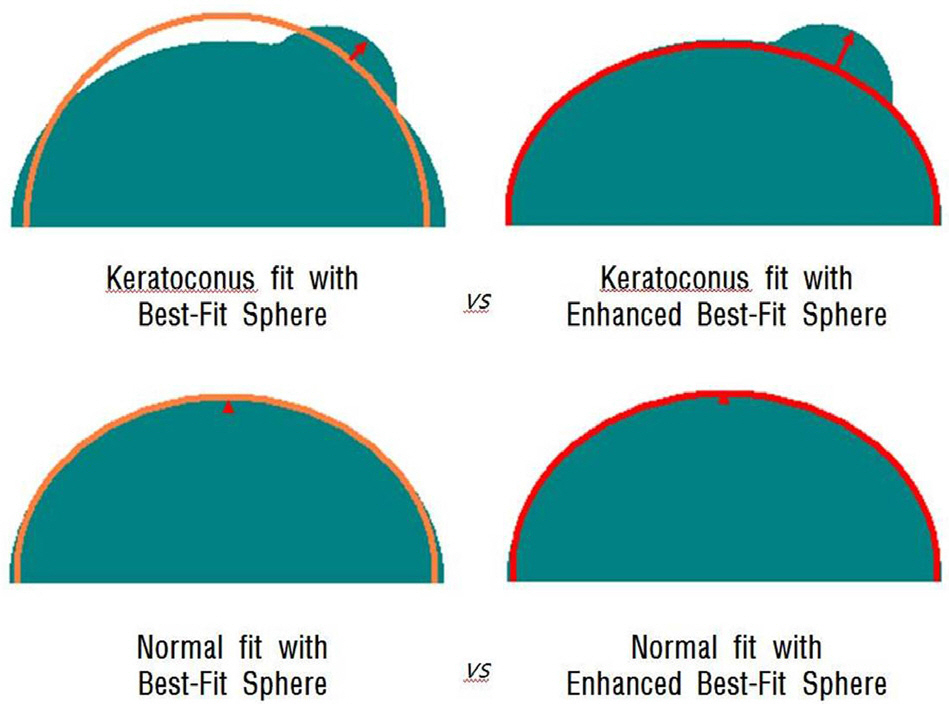J Korean Ophthalmol Soc.
2010 May;51(5):651-657.
The Evaluation of Enhanced Ectasia Display Mode in Screening for Keratoconus
- Affiliations
-
- 1Department of Ophthalmology, Soonchunhyang University College of Medicine, Bucheon, Korea. tjsdndrla@naver.com
Abstract
- PURPOSE
To estimate the utility of the enhanced ectasia display mode of Pentacam in discriminating keratoconus and keratoconus suspect from normal cornea.
METHODS
Corneal topography was measured using the Pentacam in keratoconus, keratoconus suspect and a normal control group. A best-fit sphere (BFS) and an enhanced best-fit sphere (EBFS) were used as reference surfaces for corneal elevation measurements, and measured values from both the anterior and posterior surfaces were compared among the three groups. Receiver operating characteristic (ROC) curves were used to identify the optimal posterior corneal elevation cutoff points for maximal sensitivity and specificity in discriminating keratoconus and keratoconus suspect from the normal control group.
RESULTS
Mean anterior and posterior corneal elevation were statistically higher in keratoconus than in keratoconus suspect and normal corneas. The optimal cutoff point of posterior elevation was 23 micrometer for the keratoconus group, and this value was associated with a sensitivity and a specificity of 96.7% and 98.6%, respectively for keratoconus. The optimal cutoff point of enhanced posterior elevation was 43 micrometer for the keratoconus group, and this value was associated with a sensitivity and a specificity of 96.7% and 95.5%, respectively.
CONCLUSIONS
The enhanced ectasia display mode showed similar diagnostic power to that of the conventional elevation map, and the former could be more useful in a clinical setting due to the pronounced visualization of corneal elevation.
Keyword
MeSH Terms
Figure
Reference
-
References
1. Krachmer JH, Feder RS, Belin MW. Keratoconus and related noninflammatory corneal thinning disorders. Surv Ophthalmol. 1984; 28:293–322.
Article2. Rabinowitz YS. Keratoconus. Surv Ophthalmol. 1998; 42:297–319.
Article3. Lee LR, Hirst LW, Readshaw G. Clinical detection of unilateral keratoconus. Aust N Z J Ophthalmol. 1995; 23:129–33.
Article4. Rabinowitz YS, Nesburn AB, McDonnell PJ. Videokeratography of the fellow eye in unilateral keratoconus. Ophthalmology. 1993; 100:181–6.
Article5. Rabinowitz YS. Videokeratographic indices to aid in screening for keratoconus. J Refract Surg. 1995; 11:371–9.
Article6. Meada N, Klyce SD, Smolek MK, Thompson HW. Automated abdominal screening with corneal topography analysis. Invest Ophthalmol Vis Sci. 1994; 35:2749–57.7. Mamalis N, Montgomry S, Anderson C, Miller C. Radial keratotomy in a patient with keratoconus. Refract Corneal Surg. 1991; 7:374–6.
Article8. Ellis W. Radial keratotomy in a patient with keratoconus. J Cataract Refract Surg. 1992; 18:406–9.
Article9. Seiler T, Quurke AW. Iatrogenic keratectasia after LASIK in a case of forme fruste keratoconus. J Cataract Refract Surg. 1998; 24:1007–9.
Article10. Binder PS, Lindstrom RL, Stulting RD, et al. Keratoconus and corneal ectasia after LASIK. J Cataract Refract Surg. 2005; 31:2035–8.
Article11. Rao SN, Raviv T, Majmudar PA, Epstein RJ. Role of Orbscan II in screening keratoconus suspects before refractive corneal surgery. Ophthalmology. 2002; 109:1642–6.
Article12. Choi HJ, Kim MK, Lee JL. Diagnostic criteria for keratoconus using Orbscan II slit scanning topography/pachymetry system. J Korean Ophthalmol Soc. 2004; 45:928–35.13. Lee SU, Lee CH, Lee JE, Lee JS. Corneal Topographic Study Using Orbscan II between Keratoconus and Keratoconus Suspect. J Korean Ophthalmol Soc. 2007; 48:1599–606.
Article14. de Sanctis U, Loiacono C, Richiardi L, et al. Sensitivity and specificity of posterior corneal elevation measured by Pentacam in discriminating keratoconus/subclinical keratoconus. Ophthalmology. 2008; 115:1534–9.
Article15. Miháltz K, Kovács I, Takács A, Nagy ZZ. Evaluation of Keratometric, Pachymetric, and Elevation Parameters of Keratoconic Corneas With Pentacam. Cornea. 2009; 28:976–80.
Article16. Belin MW, Khachikian SS, Ambrósio R Jr, Salomão M. Keratoconus/ecatasia detection with the oculus pentacam: Belin/Ambrósio abdominal ectasia display. Highlights of Ophthalmology. 2007; 35:5–12.17. Zadnik K, Barr JT, Edrington TB, et al. Baseline findings in the Collaborative Longitudinal Evaluation of Keratoconus (CLEK) study. Invest Ophthalmol Vis Sci. 1998; 39:2537–46.18. Schlegel Z, Hoang-Xuan T, Gatinel D. Comparison of and correlation between anterior and posterior corneal elevation maps in normal eyes and keratoconus-suspect eyes. J Cataract Refract Surg. 2008; 34:789–95.
Article
- Full Text Links
- Actions
-
Cited
- CITED
-
- Close
- Share
- Similar articles
-
- Two Cases of Recurrent Keratoconus
- Acute Hydrops after Radial Keratotomy on Keratoconus
- Effect of Sequential Intrastromal Corneal Ring Segment Implantation and Corneal Collagen Crosslinking in Corneal Ectasia
- Clinical Evaluation of Kefatoconus
- Keratectasia after Laser in Situ Keratomileusis: Clinicopathologic Case Report





